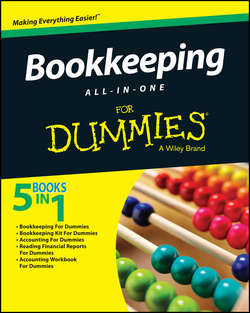Читать книгу Bookkeeping All-In-One For Dummies - Dummies Consumer - Страница 6
На сайте Литреса книга снята с продажи.
Book I
Keeping the Books
Chapter 1
Basic Bookkeeping
Delving into Bookkeeping Basics
ОглавлениеIf you don’t carefully plan your bookkeeping operation and figure out exactly how and what financial detail you want to track, you’ll have absolutely no way to measure the success (or failure, unfortunately) of your business efforts.
Bookkeeping, when done properly, gives you an excellent gauge of how well you’re doing financially. It also provides you with lots of information throughout the year so you can test the financial success of your business strategies and make course corrections early in the year if necessary to ensure that you reach your year-end profit goals.
Bookkeeping can become your best friend for managing your financial assets and testing your business strategies, so don’t shortchange it. Take the time to develop your bookkeeping system with your accountant before you even open your business’s doors and make your first sale.
Picking your accounting method: Cash basis versus accrual
You can’t keep books unless you know how you want to go about doing so. The two basic accounting methods you have to choose from are cash-basis accounting and accrual accounting. The key difference between these two accounting methods is the point at which you record sales and purchases in your books. If you choose cash-basis accounting, you only record transactions when cash changes hands. If you use accrual accounting, you record a transaction when it’s completed, even if cash doesn’t change hands.
For example, suppose your company buys products to sell from a vendor but doesn’t actually pay for those products for 30 days. If you’re using cash-basis accounting, you don’t record the purchase until you actually lay out the cash to the vendor. If you’re using accrual accounting, you record the purchase when you receive the products, and you also record the future debt in an account called Accounts Payable.
Understanding assets, liabilities, and equity
Every business has three key financial parts that must be kept in balance: assets, liabilities, and equity. Assets include everything the company owns, such as cash, inventory, buildings, equipment, and vehicles. Liabilities include everything the company owes to others, such as vendor bills, credit card balances, and bank loans. Equity includes the claims owners have on the assets based on their portion of ownership in the company.
The formula for keeping your books in balance involves these three elements:
Assets = Liabilities + Equity
Much of bookkeeping involves keeping your books in balance.
Introducing debits and credits
To keep the books, you need to revise your thinking about two common financial terms: debits and credits. Most nonbookkeepers and nonaccountants think of debits as subtractions from their bank accounts. The opposite is true with credits – people usually see these as additions to their accounts, in most cases in the form of refunds or corrections in favor of the account holders.
Well, forget all you thought you knew about debits and credits. Debits and credits are totally different animals in the world of bookkeeping. Because keeping the books involves a method called double-entry bookkeeping, you have to make at least two entries – a debit and a credit – into your bookkeeping system for every transaction. Whether that debit or credit adds or subtracts from an account depends solely upon the type of account.
Don’t worry. All this debit, credit, and double-entry stuff may sound confusing, but it will become much clearer as you work through this chapter.
Charting your bookkeeping course
You can’t just enter transactions in the books willy-nilly. You need to know where exactly those transactions fit into the larger bookkeeping system. That’s where your Chart of Accounts comes in; it’s essentially a list of all the accounts your business has and what types of transactions go into each one. Book I Chapter 2 talks more about the Chart of Accounts.
